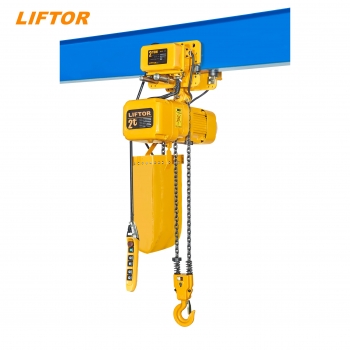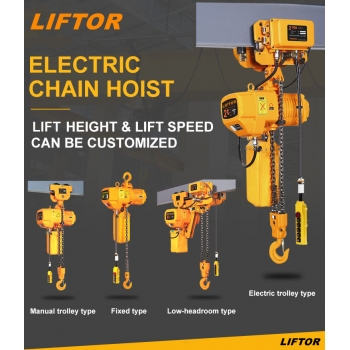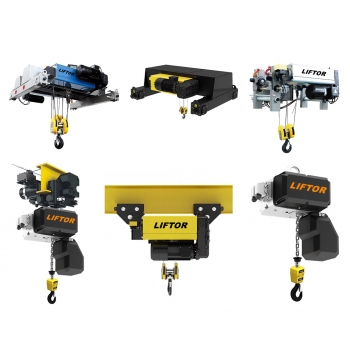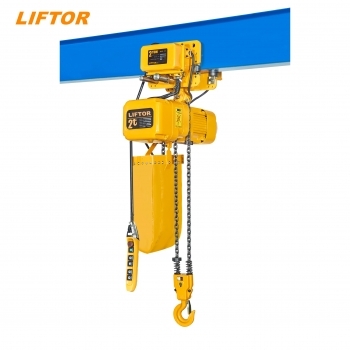
1. Inspect the Hoist Regularly
Perform visual and operational inspections to identify any signs of wear, damage, or malfunction. Key areas to check include:·
Hooks: Look for deformation, cracks, or excessive wear.
·
·
Chain or Wire Rope: Inspect for kinks, fraying, or corrosion.
·
·
Load Chain Guide: Ensure proper alignment and smooth movement.
·
·
Housing and Components: Check for visible damage, leaks, or loose parts.
·
2. Clean the Hoist
Dust, dirt, and grease can accumulate on your electric hoist, leading to decreased performance and potential hazards. To clean the hoist:·
Wipe down the exterior with a clean, dry cloth.
·
·
Use a degreaser to remove oil and grime from critical components like chains or ropes.
·
·
Avoid using water directly to prevent electrical damage.
·
3. Lubricate Moving Parts
Proper lubrication reduces friction and wear, ensuring smooth operation. Focus on:·
Chains: Use a high-quality chain lubricant to prevent rust and enhance flexibility.
·
·
Gears and Bearings: Apply manufacturer-recommended grease to internal components.
·
4. Test the Hoist’s Functionality
Before each use, conduct a brief operational test to ensure all systems are working correctly. Key tests include:·
Load Test: Lift a light load to check for smooth operation.
·
·
Control Buttons: Verify responsiveness and proper functioning of all control buttons or switches.
·
·
Brake System: Ensure the brake engages and holds securely.
·
5. Check Electrical Components
Inspect the electrical system for issues that could lead to operational failure:·
Wiring: Look for frayed, loose, or exposed wires.
·
·
Connections: Ensure all terminals and plugs are secure.
·
·
Motor: Listen for unusual sounds that may indicate internal problems.
·
6. Replace Worn or Damaged Parts
Promptly replace any components showing signs of wear or damage to avoid further issues. Use only genuine replacement parts recommended by the manufacturer.7. Keep a Maintenance Log
Maintain a detailed record of all inspections, repairs, and replacements. This log can help you track the hoist’s condition over time and ensure timely maintenance.8. Adhere to Manufacturer Guidelines
Always refer to the hoist’s user manual for specific maintenance requirements and schedules. Follow the manufacturer’s recommendations to ensure compliance with warranty terms and safety regulations.9. Train Operators and Maintenance Personnel
Ensure that everyone who operates or maintains the hoist is properly trained. Knowledgeable personnel can identify issues early and perform maintenance tasks correctly.10. Schedule Professional Inspections
In addition to routine checks, schedule regular inspections by a certified technician. Professionals can detect and address issues that may not be apparent during daily maintenance.Conclusion
Performing regular maintenance on your electric hoist is essential for its safe and efficient operation. By following these steps, you can minimize downtime, extend the hoist’s lifespan, and ensure compliance with safety standards. For complex repairs or inspections, always consult a professional to maintain the integrity of your equipment.1. Inspect the Hoist Regularly
Perform visual and operational inspections to identify any signs of wear, damage, or malfunction. Key areas to check include:·
Hooks: Look for deformation, cracks, or excessive wear.
·
·
Chain or Wire Rope: Inspect for kinks, fraying, or corrosion.
·
·
Load Chain Guide: Ensure proper alignment and smooth movement.
·
·
Housing and Components: Check for visible damage, leaks, or loose parts.
·
2. Clean the Hoist
Dust, dirt, and grease can accumulate on your electric hoist, leading to decreased performance and potential hazards. To clean the hoist:·
Wipe down the exterior with a clean, dry cloth.
·
·
Use a degreaser to remove oil and grime from critical components like chains or ropes.
·
·
Avoid using water directly to prevent electrical damage.
·
3. Lubricate Moving Parts
Proper lubrication reduces friction and wear, ensuring smooth operation. Focus on:·
Chains: Use a high-quality chain lubricant to prevent rust and enhance flexibility.
·
·
Gears and Bearings: Apply manufacturer-recommended grease to internal components.
·
4. Test the Hoist’s Functionality
Before each use, conduct a brief operational test to ensure all systems are working correctly. Key tests include:·
Load Test: Lift a light load to check for smooth operation.
·
·
Control Buttons: Verify responsiveness and proper functioning of all control buttons or switches.
·
·
Brake System: Ensure the brake engages and holds securely.
·
5. Check Electrical Components
Inspect the electrical system for issues that could lead to operational failure:·
Wiring: Look for frayed, loose, or exposed wires.
·
·
Connections: Ensure all terminals and plugs are secure.
·
·
Motor: Listen for unusual sounds that may indicate internal problems.
·



